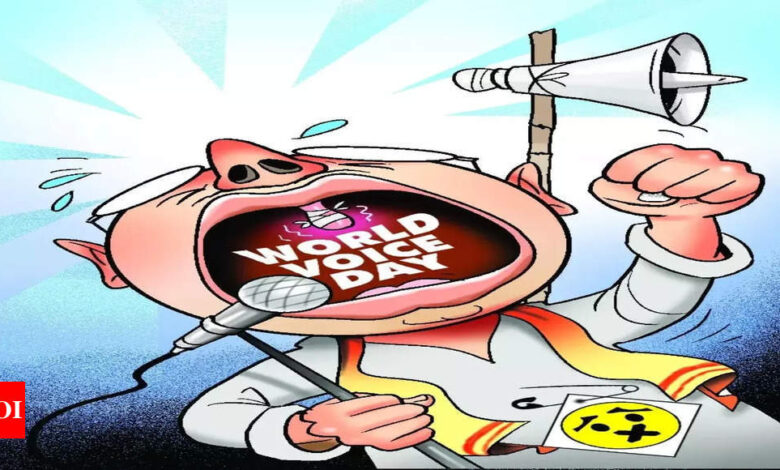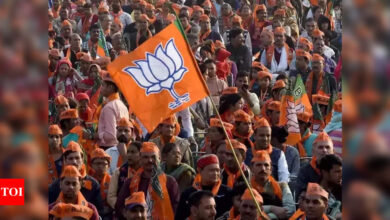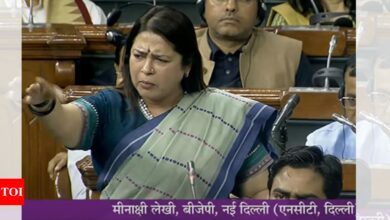India
Politicians’ vocal chords suffer silently as poll campaign picks up | India News

[ad_1]
As we brace for the impending political showdown with candidates giving it their vocal all, spare a thought for the unsung hero – the voice box – that often bears the brunt of their campaign rhetoric. With World Voice Day approaching on April 16 – a day dedicated to spotlighting the role vocal cord health plays in our personal and professional lives – it might be timely to explore how politicians, notorious for pushing their voices to the limit, struggle to keep their pipes in shape.
Voice surgeon Dr Nupur Nerurkar says she often encounters politicians with “phonotraumatic lesions” or benign growths on the vocal cords due to non-stop speeches.”I see politicians all year round. That’s because most seek help only after three to six months of symptoms,” says Nerurkar whose yearly tally sees close to 15 politicians lining up for assistance with raspy, fatigued voices.
The vocal folds, Dr Nerurkar explains, is in the shape of a ‘V’ roughly in the middle of the larynx and when one speaks, the folds vibrate 100 times in a second in men and 200 in women.
While people whose jobs require them to talk a lot are more prone to voice disorders – think singers, teachers, RJs, actors, builders, housewives, and call centre workers – “What distinguishes politicians is that they not only speak loudly and continuously but their speeches are often emotionally charged. Also, they frequently address small gatherings or party meetings without a microphone, which further increases vocal strain,” says Nerurkar.
Based on a study that Nerurkar had conducted in 2016, politicians tend to fit into a personality type, with an increased chance of developing these vocal disorders.
Researchers examined 100 individuals, half with vocal issues and half with healthy vocal cords, analysing personality traits, speech speed, and volume to identify factors causing polyps, nodules, and cysts. Interestingly, it wasn’t speech speed or volume that mattered most, but personality type. “Type A individuals, known for speaking loudly and quickly, were more prone to vocal problems compared to Type B who spoke more softly and slowly. Politicians typically fall into the Type A,” she said.
It’s become a familiar sight over the years for audiologist and speech therapist Dr Piyush Gujarathi, to see politicians flocking to him with voice woes. “When their voice takes a hit, politicians tend to get jittery because speech holds immense importance for them. They feel under confident if they’re unable to project their voice.”
However, unlike stage performers who are more cautious of their limits, politicians tend to shrug it off as a sore throat . “And typically end up in the doctor’s chamber at an acute stage when severity has peaked.”
According to ENT specialist Dr Milind Navalakhe, the development of vocal lesions among politicians is often a gradual process, when an unyielding hoarse voice or sudden bleeding prompts them to seek medical attention.
“I’ve seen politicians with polyps and also cases with subepithelial haemorrhage – the bursting of blood vessels beneath the vocal folds,” says Dr Nerurkar who has performed micro laryngeal surgeries on several of them. “I’ve also had politicians come with spasmodic dysphonia where muscles in the voice box go into spasm while talking.”
Symptoms of vocal cord edema – hoarseness, pain, change of pitch, inability to speak – had crept up slowly, prompting three politicians – Samajwadi’s Rais Shaikh, Bala Nandgaonkar of MNS and Congress’s Neelam Dolas -to finally seek medical help after a month of enduring the discomfort while campaigning for 2014 assembly elections. The trio were advised 20-day ‘voice rest’ by doctors after they damaged their vocal cords while giving loud speeches and addressing non-stop public meetings.
Former Indian cricketer turned Congress leader Navjot Singh Sindhu had a similar experience during Lok Sabha election in 2019 when he damaged his vocal cords after speaking at 80 political rallies in 28 days.
“The issue is that they keep at it without much regard for vocal hygiene – forgetting to slow down, sip water in between speeches and resist the urge to shout into the microphone,” says Navalakhe. “In the initial stages, conservative medical management and speech therapy can resolve the issues. Surgery becomes necessary when nodules fail to respond to therapy,” says Navalakhe, noting that around 10% of his patients are politicians.
But post-op, is where the real challenge is. Patients require at least seven days of voice rest. “And getting them to follow that up with voice therapy is another uphill battle,” says Dr Nerurkar of breaking ingrained vocal habits with proper volume control, speech speed, microphone usage, and relaxation techniques to prevent nodules from reappearing.
Voice surgeon Dr Nupur Nerurkar says she often encounters politicians with “phonotraumatic lesions” or benign growths on the vocal cords due to non-stop speeches.”I see politicians all year round. That’s because most seek help only after three to six months of symptoms,” says Nerurkar whose yearly tally sees close to 15 politicians lining up for assistance with raspy, fatigued voices.
The vocal folds, Dr Nerurkar explains, is in the shape of a ‘V’ roughly in the middle of the larynx and when one speaks, the folds vibrate 100 times in a second in men and 200 in women.
While people whose jobs require them to talk a lot are more prone to voice disorders – think singers, teachers, RJs, actors, builders, housewives, and call centre workers – “What distinguishes politicians is that they not only speak loudly and continuously but their speeches are often emotionally charged. Also, they frequently address small gatherings or party meetings without a microphone, which further increases vocal strain,” says Nerurkar.
Based on a study that Nerurkar had conducted in 2016, politicians tend to fit into a personality type, with an increased chance of developing these vocal disorders.
Researchers examined 100 individuals, half with vocal issues and half with healthy vocal cords, analysing personality traits, speech speed, and volume to identify factors causing polyps, nodules, and cysts. Interestingly, it wasn’t speech speed or volume that mattered most, but personality type. “Type A individuals, known for speaking loudly and quickly, were more prone to vocal problems compared to Type B who spoke more softly and slowly. Politicians typically fall into the Type A,” she said.
It’s become a familiar sight over the years for audiologist and speech therapist Dr Piyush Gujarathi, to see politicians flocking to him with voice woes. “When their voice takes a hit, politicians tend to get jittery because speech holds immense importance for them. They feel under confident if they’re unable to project their voice.”
However, unlike stage performers who are more cautious of their limits, politicians tend to shrug it off as a sore throat . “And typically end up in the doctor’s chamber at an acute stage when severity has peaked.”
According to ENT specialist Dr Milind Navalakhe, the development of vocal lesions among politicians is often a gradual process, when an unyielding hoarse voice or sudden bleeding prompts them to seek medical attention.
“I’ve seen politicians with polyps and also cases with subepithelial haemorrhage – the bursting of blood vessels beneath the vocal folds,” says Dr Nerurkar who has performed micro laryngeal surgeries on several of them. “I’ve also had politicians come with spasmodic dysphonia where muscles in the voice box go into spasm while talking.”
Symptoms of vocal cord edema – hoarseness, pain, change of pitch, inability to speak – had crept up slowly, prompting three politicians – Samajwadi’s Rais Shaikh, Bala Nandgaonkar of MNS and Congress’s Neelam Dolas -to finally seek medical help after a month of enduring the discomfort while campaigning for 2014 assembly elections. The trio were advised 20-day ‘voice rest’ by doctors after they damaged their vocal cords while giving loud speeches and addressing non-stop public meetings.
Former Indian cricketer turned Congress leader Navjot Singh Sindhu had a similar experience during Lok Sabha election in 2019 when he damaged his vocal cords after speaking at 80 political rallies in 28 days.
“The issue is that they keep at it without much regard for vocal hygiene – forgetting to slow down, sip water in between speeches and resist the urge to shout into the microphone,” says Navalakhe. “In the initial stages, conservative medical management and speech therapy can resolve the issues. Surgery becomes necessary when nodules fail to respond to therapy,” says Navalakhe, noting that around 10% of his patients are politicians.
But post-op, is where the real challenge is. Patients require at least seven days of voice rest. “And getting them to follow that up with voice therapy is another uphill battle,” says Dr Nerurkar of breaking ingrained vocal habits with proper volume control, speech speed, microphone usage, and relaxation techniques to prevent nodules from reappearing.
#Politicians #vocal #chords #suffer #silently #poll #campaign #picks #India #News






